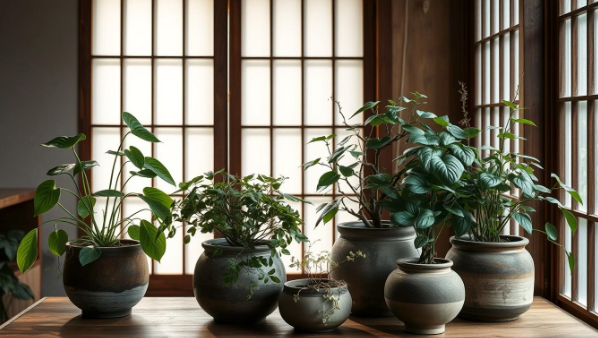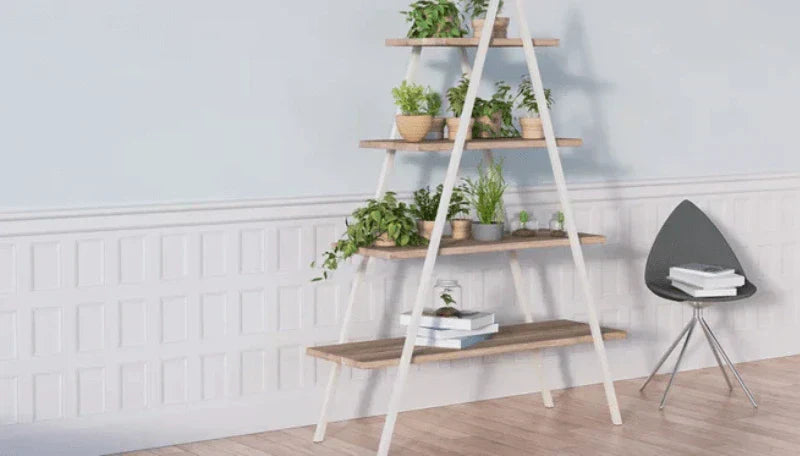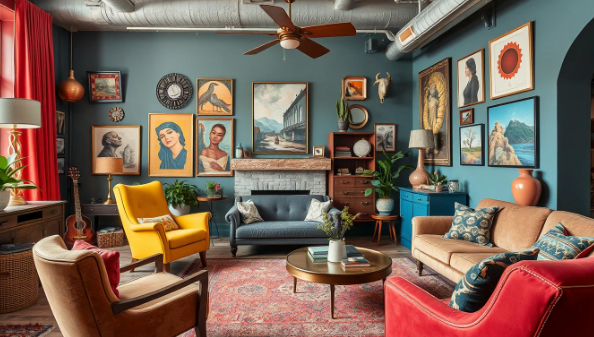Wabi-sabi is a Japanese philosophy that celebrates the beauty of imperfection and naturalness. In interior design, wabi-sabi means focusing on simplicity, natural materials and timeless peace. This style is perfect for people who value authenticity and are looking for a way to create a cozy and peaceful interior in Japanese style.
In a world dominated by the pursuit of perfection, wabi-sabi offers a refreshing perspective on living spaces. The wabi-sabi style promotes the use of natural materials such as wood, stone, cotton and linen, which evolve over time. Interior design in the wabi-sabi style is not only a matter of aesthetics, but also a philosophy of life.

Wabi-sabi emphasizes the need for attention to detail — it is recommended to use minimalist decorations that reflect the principles of harmony and simplicity. Global interest in the wabi-sabi style is growing and contributing to its increasing popularity in interior design. If you are looking for a way to create a cozy and calm interior, wabi-sabi may be the perfect choice.
Wabi-sabi philosophy in the home space
The philosophy of wabi-sabi is a unique combination of Japanese aesthetics and spirituality that celebrates the beauty of imperfection and naturalness. In the home, the philosophy of wabi-sabi can be applied to create an atmosphere of peace and harmony. The origins of wabi-sabi date back to 12th century Japan, where the philosophy was born in close connection with Zen Buddhism.
Wabi-sabi in the home space is not only an aesthetic, but also a way of life. It includes simplicity, naturalness and respect for materials and objects.
The basic aesthetic principles of wabi-sabi are:
- Simplicity and minimalism
- Naturalness and authenticity
- Respect for materials and objects
The differences between wabi-sabi and modernism are clear. Wabi-sabi values naturalness and authenticity, while modernism often emphasizes modernity and innovation. Wabi-sabi is also a way of life that promotes peace and harmony in the home. Wabi-sabi in the home can be applied in a variety of ways, from choosing materials and furniture, to arranging the space and choosing colors. The key is to create an atmosphere of peace and harmony that promotes relaxation and well-being.
|
Style |
Description |
|
Wabi-sabi |
Japanese philosophy that celebrates the beauty of imperfection and naturalness |
|
Modernism |
A style that focuses on modernity and innovation |
Natural materials as the foundation of wabi-sabi style
Wabi-sabi is a style that emphasizes the value of naturalness and the lack of perfection in interior design. Natural materials are the foundation of this style, and their use allows you to create cozy and peaceful interiors.
Examples of natural materials used in wabi-sabi include:
- raw wood (e.g. furniture, such as wooden desks or chests of drawers )
- stone,
- clay,
- natural fibers,
These materials not only add a cozy feel to a room, but they also age beautifully over time. Wabi-sabi is a style that is gaining popularity in the West, especially among those looking to escape the idealized standards of living dominated by social media.
Wabi-sabi promotes the reuse of objects, which is a valuable motive compared to the high consumerism characteristic of many other interior styles. Therefore, by choosing natural materials , we can not only create beautiful and cozy interiors, but also contribute to the protection of the environment.
Colors and textures characteristic of interior design in the Japanese wabi-sabi style
Wabi-sabi style is not only a philosophy, but also an aesthetic that is based on the beauty of imperfection. Wabi-sabi interiors are dominated by wabi-sabi colors , which are associated with nature. An earthy color palette is characteristic of this style, and includes earthy tones such as beiges, browns, greens, and grays. Wabi-sabi textures also play an important role in creating a wabi-sabi atmosphere. Natural materials such as wood, stone, and ceramic are used to create unique textures that add warmth and depth to the space.

Earth Color Palette
The earthy color palette is the foundation of wabi-sabi style. It includes earthy tones such as beiges, browns, greens and grays. These colors are associated with nature and add peace and harmony to a space.
Organic surface textures
Organic surface textures, such as wood, stone and ceramic , are used to create unique textures that add warmth and depth to the space. These materials are not only aesthetically pleasing, but also ecologically sound and durable.
|
Material |
Characteristic |
|
Wood |
Natural, warm, durable |
|
Stone |
Natural, durable, elegant |
|
Ceramics |
Natural, handcrafted, unique |
Minimalism and simplicity in organizing space
Wabi-sabi is a style that values minimalist simplicity and functionality. This style promotes simplicity and functionality, which is visible in interior design. Minimalist interiors are not only aesthetically pleasing, but also promote peace and harmony in the home space.
Minimalism and simplicity in organizing space are key elements of the wabi-sabi style.
Here are the benefits of using these elements:
- They improve the aesthetics of the interior,
- They make it easier to keep things tidy,
- They create a peaceful atmosphere,
- They promote functionality.
Wabi-sabi is a style that combines minimalist simplicity with functionality. Thanks to this, we can create a space that is not only beautiful, but also functional and peaceful.
Furniture and accessories in line with the wabi-sabi philosophy
Wabi-sabi furniture is more than just furniture, it is part of a philosophy of life that values simplicity, naturalness and authenticity. Wabi-sabi accessories , such as ceramics, also play an important role in creating a cozy and peaceful interior.
Ceramics and everyday objects
Pottery is one of the characteristic elements of wabi-sabi style. Hand-made pottery and decorations add warmth and authenticity to the interior. The art of kintsugi, which involves repairing objects with gold or silver paint, is also popular in wabi-sabi decorations.
The art of kintsugi in decorations
The art of kintsugi is not only a way of repairing objects, but also an art form that celebrates the beauty of imperfection. In wabi-sabi decorations, the art of kintsugi is used to create unique and authentic decorative pieces.
Examples of wabi-sabi furniture and accessories:
- wooden furniture with visible grain and wicks,
- handcrafted ceramics,
- kintsugi art decorations.
Plants and natural elements in the arrangement
Wabi-sabi plants are not only a decoration, but also an element that introduces a cozy atmosphere to the interior. Natural elements such as wood, stone and ceramics are also important components of the wabi-sabi style.
Ikebana as a decorative element
Ikebana , or the Japanese art of flower arrangement, is a characteristic element of the wabi-sabi style. Ikebana adds a cozy and natural atmosphere to the interior.
In the wabi-sabi style, plants and natural elements are used to create a harmonious and peaceful atmosphere.
Here are some examples of plants that can be used in a wabi-sabi arrangement:
- Green plants such as ferns and succulents,
- Flowers like cherry and sunflowers,
- Trees such as bamboo and pine.

Natural elements such as wood, stone and ceramics are also important components of the wabi-sabi style. These materials add warmth and authenticity to the interior.
Adapting wabi-sabi to small apartments
Wabi-sabi is a style that celebrates the beauty of imperfection. It can be adapted to small apartments, which is ideal for people who value authenticity and are looking for a way to create a cozy and calm interior. Natural materials and minimalist simplicity are key elements of the wabi-sabi style that can be used in small apartments.

Here are some tips on how to adopt wabi-sabi in small apartments :
- Use natural materials such as wood and stone to create furniture and decorations,
- Use minimalist solutions, such as simple forms and subdued colors,
- Add natural elements like plants and flowers to your interior.
For example, you can use natural materials such as wood to create furniture, and also use minimalist solutions such as simple shapes and muted colors. Adding elements of nature such as plants and flowers can also help create a cozy and peaceful interior.
Harmony of imperfections - the art of creating a cozy interior
The wabi-sabi style is a unique art of creating cozy and harmonious interiors , which is characterized by the acceptance of imperfection. This Japanese philosophy celebrates beauty in nature and authenticity , offering a peaceful oasis in a rapidly changing world. The key to creating an interior in the wabi-sabi style is a harmonious combination of simplicity, natural materials and muted colors . Simple furniture shapes, organic textures and delicate colors create a cozy atmosphere, conducive to peace and contemplation.
Giving up perfectionism and accepting imperfection gives the space a unique character.
The wabi-sabi philosophy is a reflection of the growing need for balance and peace in our homes. It is a departure from cold modernism in favor of warmth, harmony and authenticity - features that make the interior a true refuge for the soul.





